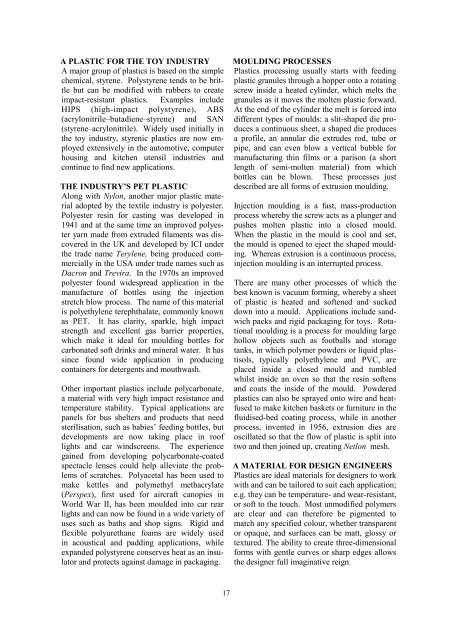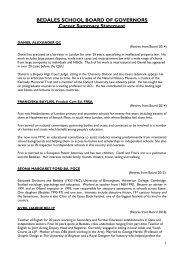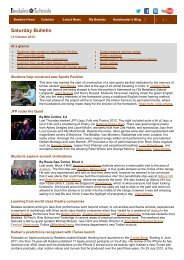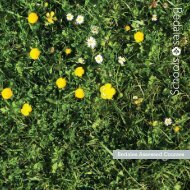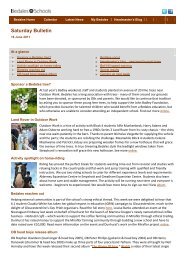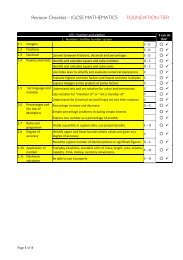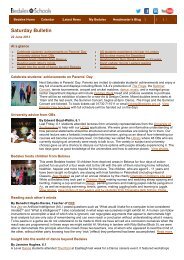Create successful ePaper yourself
Turn your PDF publications into a flip-book with our unique Google optimized e-Paper software.
A PLASTIC FOR THE TOY INDUSTRYA major group of plastics is based on the simplechemical, styrene. Polystyrene tends to be brittlebut can be modified with rubbers to createimpact-resistant plastics. Examples includeHIPS (high-impact polystyrene), ABS(acrylonitrile–butadiene–styrene) and SAN(styrene–acrylonitrile). Widely used initially inthe toy industry, styrenic plastics are now employedextensively in the automotive, computerhousing and kitchen utensil industries andcontinue to find new applications.THE INDUSTRY’S PET PLASTICAlong with Nylon, another major plastic materialadopted by the textile industry is polyester.Polyester resin for casting was developed in1941 and at the same time an improved polyesteryarn made from extruded filaments was discoveredin the UK and developed by ICI underthe trade name Terylene, being produced commerciallyin the USA under trade names such asDacron and Trevira. In the 1970s an improvedpolyester found widespread application in themanufacture of bottles using the injectionstretch blow process. The name of this materialis polyethylene terephthalate, commonly knownas PET. It has clarity, sparkle, high impactstrength and excellent gas barrier properties,which make it ideal for moulding bottles forcarbonated soft drinks and mineral water. It hassince found wide application in producingcontainers for detergents and mouthwash.Other important plastics include polycarbonate,a material with very high impact resistance andtemperature stability. Typical applications arepanels for bus shelters and products that needsterilisation, such as babies’ feeding bottles, butdevelopments are now taking place in rooflights and car windscreens. The experiencegained from developing polycarbonate-coatedspectacle lenses could help alleviate the problemsof scratches. Polyacetal has been used tomake kettles and polymethyl methacrylate(Perspex), first used for aircraft canopies inWorld War II, has been moulded into car rearlights and can now be found in a wide variety ofuses such as baths and shop signs. Rigid andflexible polyurethane foams are widely usedin acoustical and padding applications, whileexpanded polystyrene conserves heat as an insulatorand protects against damage in packaging.MOULDING PROCESSESPlastics processing usually starts with feedingplastic granules through a hopper onto a rotatingscrew inside a heated cylinder, which melts thegranules as it moves the molten plastic forward.At the end of the cylinder the melt is forced intodifferent types of moulds: a slit-shaped die producesa continuous sheet, a shaped die producesa profile, an annular die extrudes rod, tube orpipe, and can even blow a vertical bubble formanufacturing thin films or a parison (a shortlength of semi-molten material) from whichbottles can be blown. These processes justdescribed are all forms of extrusion moulding.Injection moulding is a fast, mass-productionprocess whereby the screw acts as a plunger andpushes molten plastic into a closed mould.When the plastic in the mould is cool and set,the mould is opened to eject the shaped moulding.Whereas extrusion is a continuous process,injection moulding is an interrupted process.There are many other processes of which thebest known is vacuum forming, whereby a sheetof plastic is heated and softened and suckeddown into a mould. Applications include sandwichpacks and rigid packaging for toys. Rotationalmoulding is a process for moulding largehollow objects such as footballs and storagetanks, in which polymer powders or liquid plastisols,typically polyethylene and PVC, areplaced inside a closed mould and tumbledwhilst inside an oven so that the resin softensand coats the inside of the mould. Powderedplastics can also be sprayed onto wire and heatfusedto make kitchen baskets or furniture in thefluidised-bed coating process, while in anotherprocess, invented in 1956, extrusion dies areoscillated so that the flow of plastic is split intotwo and then joined up, creating Netlon mesh.A MATERIAL FOR DESIGN ENGINEERSPlastics are ideal materials for designers to workwith and can be tailored to suit each application;e.g. they can be temperature- and wear-resistant,or soft to the touch. Most unmodified polymersare clear and can therefore be pigmented tomatch any specified colour, whether transparentor opaque, and surfaces can be matt, glossy ortextured. The ability to create three-dimensionalforms with gentle curves or sharp edges allowsthe designer full imaginative reign.17


